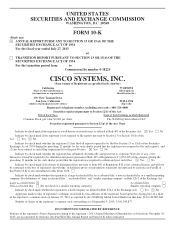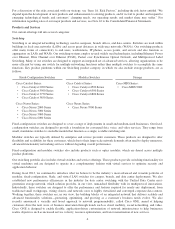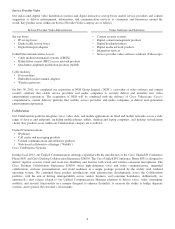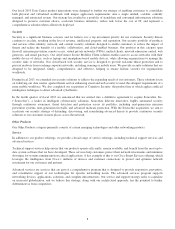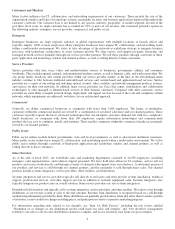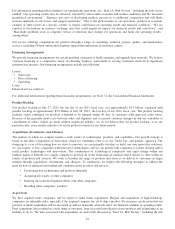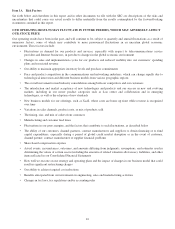Cisco 2013 Annual Report Download - page 17
Download and view the complete annual report
Please find page 17 of the 2013 Cisco annual report below. You can navigate through the pages in the report by either clicking on the pages listed below, or by using the keyword search tool below to find specific information within the annual report.Customers and Markets
Many factors influence the IT, collaboration, and networking requirements of our customers. These include the size of the
organization, number and types of technology systems, geographic location, and business applications deployed throughout the
customer’s network. Our customer base is not limited to any specific industry, geography, or market segment. In each of the
past three fiscal years, no single customer has accounted for 10% or more of our revenue. Our customers primarily operate in
the following markets: enterprise, service provider, commercial, and public sector.
Enterprise
Enterprise businesses are large regional, national, or global organizations with multiple locations or branch offices and
typically employ 1,000 or more employees. Many enterprise businesses have unique IT, collaboration, and networking needs
within a multivendor environment. We strive to take advantage of the network-as-a-platform strategy to integrate business
processes with technology architectures to assist customer growth. We offer service and support packages, financing, and
managed network services primarily through our service provider partners. We sell these products through a network of third-
party application and technology vendors and channel partners, as well as selling directly to these customers.
Service Providers
Service providers offer data, voice, video, and mobile/wireless services to businesses, governments, utilities, and consumers
worldwide. They include regional, national, and international wireline carriers, as well as Internet, cable, and wireless providers. We
also group media, broadcast, and content providers within our service provider market, as the lines in the telecommunications
industry continue to blur between traditional network-based services and content-based and application-based services. Service
providers use a variety of our routing and switching, optical, security, video, mobility, and network management products, systems,
and services for their own networks. In addition, many service providers use Cisco data center, virtualization, and collaboration
technologies to offer managed or Internet-based services to their business customers. Compared with other customers, service
providers are more likely to require network design, deployment, and support services because of the scale and complexity of their
networks, which requirements are addressed, we believe, by our architectural approach.
Commercial
Generally, we define commercial businesses as companies with fewer than 1,000 employees. The larger, or midmarket,
customers within the commercial market are served by a combination of our direct salesforce and our channel partners. These
customers typically require the latest advanced technologies that our enterprise customers demand, but with less complexity.
Small businesses, or companies with fewer than 100 employees, require information technologies and communication
products that are easy to configure, install, and maintain. These smaller companies within the commercial market are primarily
served by our channel partners.
Public Sector
Public sector entities include federal governments, state and local governments, as well as educational institution customers.
Many public sector entities have unique IT, collaboration, and networking needs within a multivendor environment. We sell to
public sector entities through a network of third-party application and technology vendors and channel partners, as well as
selling directly to these customers.
Sales Overview
As of the end of fiscal 2013, our worldwide sales and marketing departments consisted of 24,938 employees, including
managers, sales representatives, and technical support personnel. We have field sales offices in 94 countries, and we sell our
products and services both directly and through a variety of channels with support from our salesforce. A substantial portion of
our products and services is sold through our channel partners, and the remainder is sold through direct sales. Our channel
partners include systems integrators, service providers, other resellers, and distributors.
Systems integrators and service providers typically sell directly to end users and often provide system installation, technical
support, professional services, and other support services in addition to network equipment sales. Systems integrators also
typically integrate our products into an overall solution. Some service providers are also systems integrators.
Distributors hold inventory and typically sell to systems integrators, service providers, and other resellers. We refer to sales through
distributors as our two-tier system of sales to the end customer. Revenue from distributors is recognized based on a sell-through
method using information provided by them. These distributors are generally given business terms that allow them to return a portion
of inventory, receive credits for changes in selling prices, and participate in various cooperative marketing programs.
For information regarding risks related to our channels, see “Item 1A. Risk Factors,” including the risk factors entitled
“Disruption of or changes in our distribution model could harm our sales and margins” and “Our inventory management
relating to our sales to our two-tier distribution channel is complex, and excess inventory may harm our gross margins.”
9


